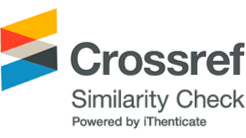-
Animal
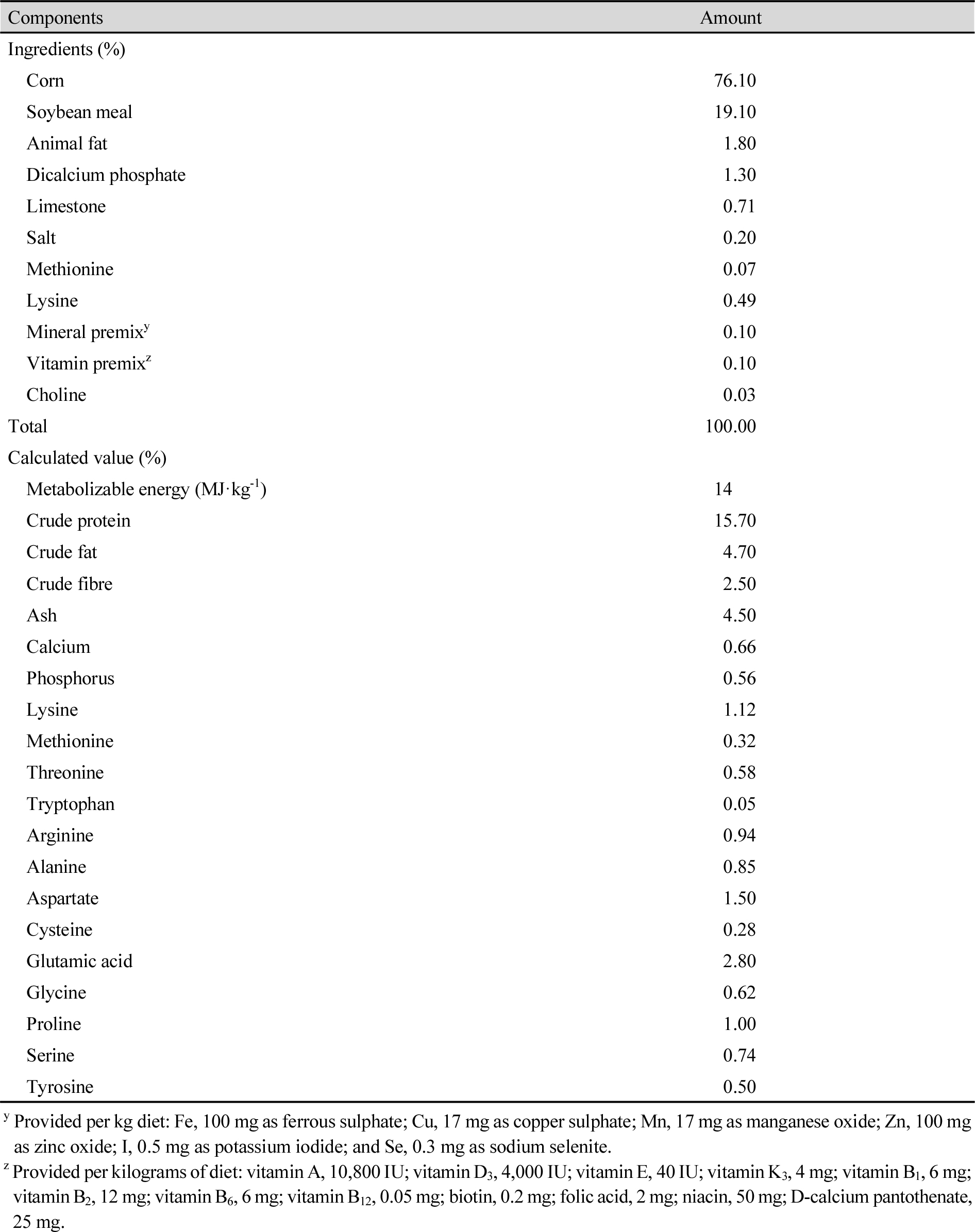
- Response of growing pig in dietary sucrose supplementation on growth performance, nutrient digestibility, fecal score, and serum cortisol
- Md Mortuza Hossain, In Ho Kim
- Sucrose is a common disaccharide sugar that is used in pig diet mainly as an energy source as well as to improve …
- Sucrose is a common disaccharide sugar that is used in pig diet mainly as an energy source as well as to improve the palatability of diet. This study investigated the effects of dietary sucrose supplementation on the growth performance, nutrient digestibility, fecal score, and serum cortisol of growing pigs. A total of 96 growing pigs were randomly allocated into three treatment groups (8 repetitions per treatment, 4 pigs per pen). Dietary treatments included: control (CON), basal diets; treatment 1 (TRT1), basal diet with 0.75% sucrose; and treatment 2 (TRT2), basal diet with 1% sucrose. Dietary sucrose supplementation tended to improve (p < 0.10) the average daily gain compared to CON group. Moreover, increased (p < 0.05) feed intake was found in the sucrose supplemented group compared to the CON group. In comparison to the CON diet the nutrient digestibility of energy tended to increase (p < 0.10) by sucrose supplemented diet. Fecal score was not altered through dietary sucrose supplementation. Decreased (p < 0.05) serum cortisol was found in both the 0.75% sucrose and 1% sucrose supplemented diet than the CON diet. In conclusion, sucrose can be a suitable feed ingredient for growing pigs as it can improve the palatability of diet as well as feed intake, energy digestibility and reduce stress through reducing serum cortisol. - COLLAPSE
-
Management & Economics
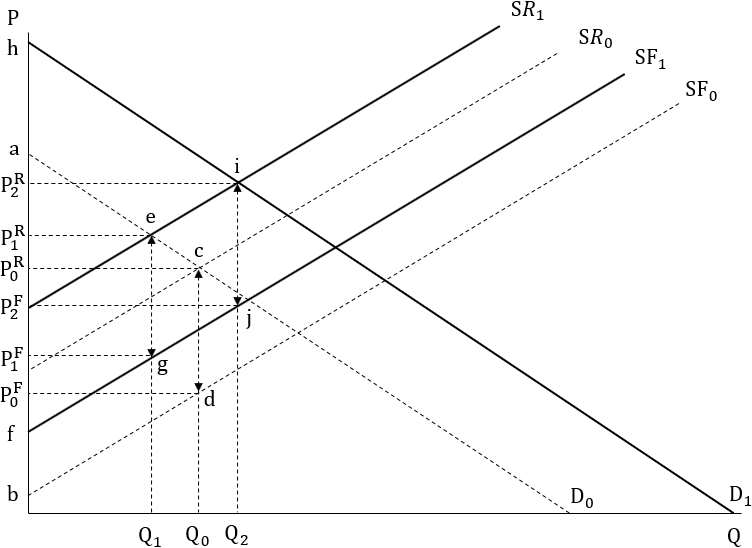
- The economic impact of mandatory group housing for pregnant sows in the pig industry
- Do Yeon Park, Suk Ho Han, Seungmo Koo
- Starting from 2030, mandatory group housing for pregnant sows on pig farms has been enforced, requiring to secure the group housing spaces …
- Starting from 2030, mandatory group housing for pregnant sows on pig farms has been enforced, requiring to secure the group housing spaces for pregnant sows. Additionally, six weeks after mating, pregnant sows are obligated to be raised in group housing spaces, and, the use of individual stalls is prohibited. This study analyzed the impact of mandatory group housing for pregnant sows on the pig industry using the equilibrium displacement model (EDM). The results showed a decrease in production due to the increase in space allocation per sow, but more significantly, consumers’ willingness to pay, driven by animal welfare considerations, increased. This led to the increase in retail prices and farm prices by 13% and 25%, respectively. Analyzing the changes in social welfare, consumer surplus is increased by 5,887 billion won, and producer surplus is also increased by 10,655 billion won, contributing to the total increase in social welfare of 16,542 billion won. This suggests that the mandatory group housing for pregnant sows have positive impacts on both consumers and producers. However, this study did not consider the cost aspect, and, therefore future research is required to address the issue of cost. - COLLAPSE
-
Plant & Forest

- Effect of biochar derived from rice husk and chicken manure on lettuce growth and soil chemical properties
- Jun-Yeong Lee, Do-Gyun Park, Yun-Gu Kang, Jun-Ho Kim, Ji-Hoon Kim, Ji-Won Choi, Yeo-Uk Yun, Taek-Keun Oh
- The application of biochar to soil for sustainable agriculture has been considered to have a positive impact on soil fertility and crop …
- The application of biochar to soil for sustainable agriculture has been considered to have a positive impact on soil fertility and crop productivity. In this study, biochar derived from rice husk and chicken manure was applied to the soil at rates of 1% and 3% by weight, respectively, for lettuce cultivation experiments. The results indicated that both rice husk biochar and chicken manure biochar were effective in improving soil fertility through soil pH correction and increased nutrient content. The nitrogen content and pH of the biochar increased the available nitrogen and phosphate in the soil, creating a soil environment conducive to the growth enhancement of lettuce. In particular, after the application of 3% chicken manure biochar, the soil exhibited the highest levels of available nitrogen and phosphate at 87.42 mg·kg-1 and 69.07 mg·kg-1, respectively. Plant fresh weight increased with rising biochar amount, with the 3% chicken manure biochar treatment (228.25 g·plant-1 fresh weight [FW]) exhibiting superior fresh weight compared to 3% rice husk biochar treatment (120.88 g·plant-1 FW). The nutrient content in lettuce, except for K2O, was higher in the chicken manure biochar treatment compared to the same dosage of rice husk biochar. Therefore, for enhancing lettuce productivity and soil fertility, chicken manure biochar appears to be more effective than rice husk biochar, and increasing the application rate up to 3% showed improvement effects without adverse impacts. However, excessive application of chicken manure biochar may lead to an increase in soil pH and electrical conductivity (EC) beyond the optimal range, requiring further assessment of application rates. - COLLAPSE
-
Animal
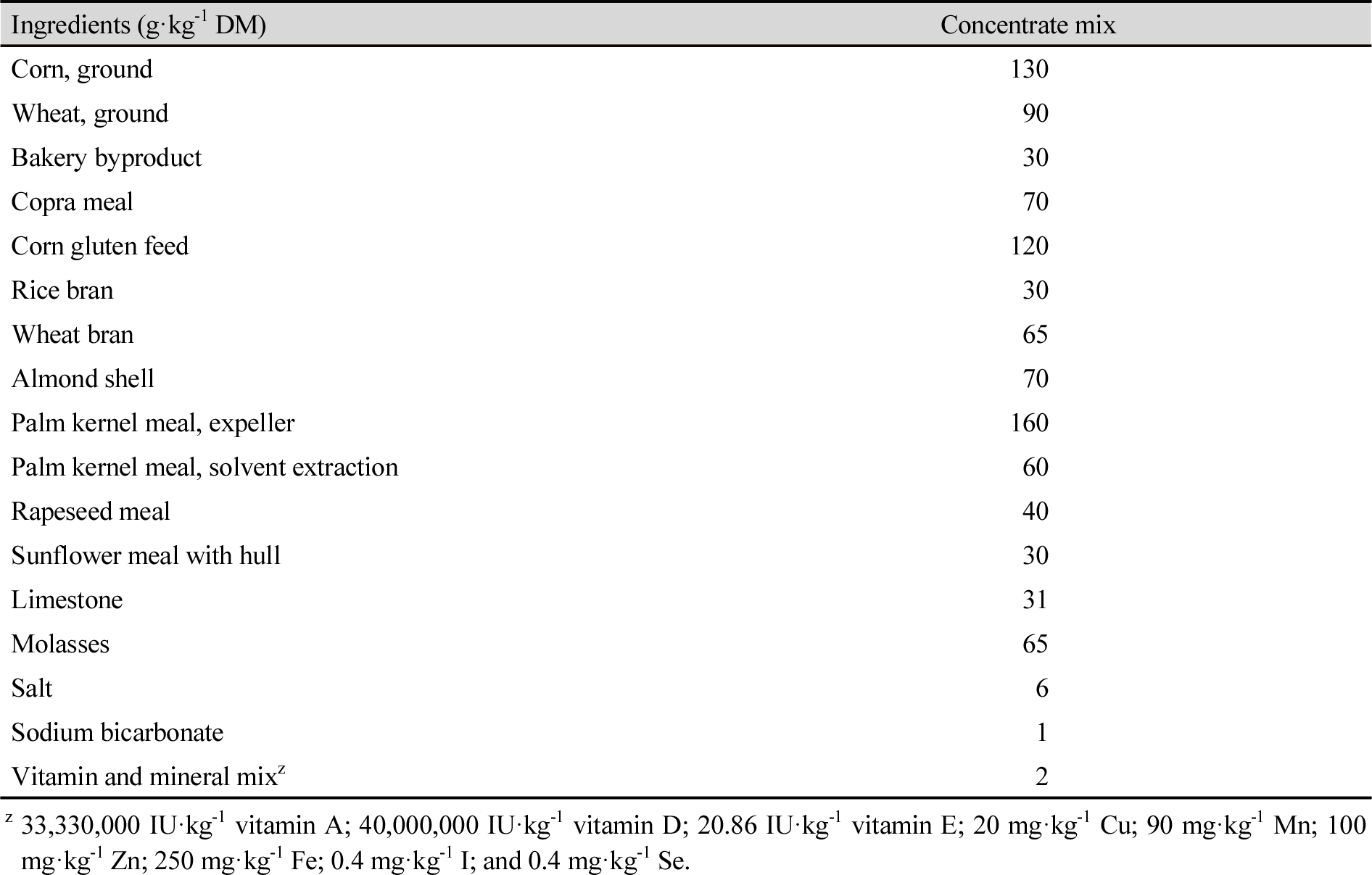
- Concentrate supplementation: A way to mitigate enteric methane emissions in pregnant Hanwoo heifers
- Md Raihanul Hoque, Hyunjin Cho, Mingyung Lee, Jakeyom Seo, Sangsuk Lee, Seongwon Seo
- The objective of this study was to investigate the effect of supplementing concentrates in a forage-based diet on methane emissions of pregnant …
- The objective of this study was to investigate the effect of supplementing concentrates in a forage-based diet on methane emissions of pregnant Hanwoo heifers. Twenty-one pregnant Hanwoo heifers (481 ± 42.4 kg) were divided into two groups: 1) a group receiving forage only (control, CON) and 2) the other group receiving forage with 4 kg of a concentrate mix (treatment, TRT). Methane (CH4) concentration was measured using a laser methane detector, following an 18-d adaptation period, according to previously established protocols. Feed intake was recorded throughout the experimental period. Ruminal fluid was collected and analyzed for pH, ammonia-nitrogen (NH3-N), and volatile fatty acid (VFA). The TRT exhibited higher dry matter and neutral detergent fiber intake than CON (p < 0.05) with elevated NH3-N (p < 0.001) and total VFA concentrations (p = 0.013). The proportions of butyrate, valerate, and iso-valerate were higher in TRT than CON (p < 0.05). Notably, CH4 concentrations per kg dry matter intake was lower in the TRT group, both from respiration and eructation (p < 0.05). In conclusion, supplementing concentrates in a low-quality forage-based diet for pregnant Hanwoo heifers fulfills nutrient requirements and reduces CH4 emissions, suggesting a potential strategy to reduce environmental impact of Hanwoo production. - COLLAPSE
-
Engineering
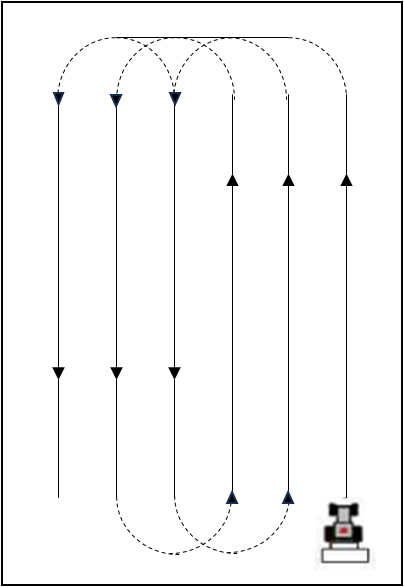
- Dynamic characteristics of a tractor cabin during plow tillage and rotary tillage
- Jong Dae Park, Min Jong Park, Seung Min Baek, Seung Yun Baek, Hyeon Ho Jeon, Dae Wun Kim, Dae Seung Hwang, Yong Joo Kim
- Due to the environment of irregular soil characteristic for agricultural fields, dynamic characteristic occurs in the tractor cabin during agricultural operations. Operator’s …
- Due to the environment of irregular soil characteristic for agricultural fields, dynamic characteristic occurs in the tractor cabin during agricultural operations. Operator’s fatigue is increased, and operation performance is decreased by these irregular environment conditions. This study was conducted to measure and analyze the dynamic characteristic of a tractor cabin, a major agriculture machinery, during agricultural operations. The specification of tractor used in the study was a 95 kW class tractor. To analyze the dynamic characteristics of the tractor cabin, the main agricultural operations, plow tillage and rotary tillage, were selected. To measure data of dynamic characteristic of the cabin, which continuously changes during operations, an Ellipse Series INS (inertia navigation system) with a built-in IMU (inertia measurement unit) was attached to the center of gravity of the cabin. During field test, the gear stages of plow tillage were B4 (4.3 km·h-1) and B5 (5.6 km·h-1), and the gear stages of rotary tillage were A3 (3.3 km·h-1) and A4 (4.2 km·h-1), which are the most commonly used. To analyze dynamic characteristic such as roll and pitch during operations according to the gear stages. As a result, the dynamic characteristics of pitch increased more than the dynamic characteristics of roll as the travel speed increased, and the dynamic characteristics of both agricultural operations were in the range of 2 to 5°. - COLLAPSE
-
Animal
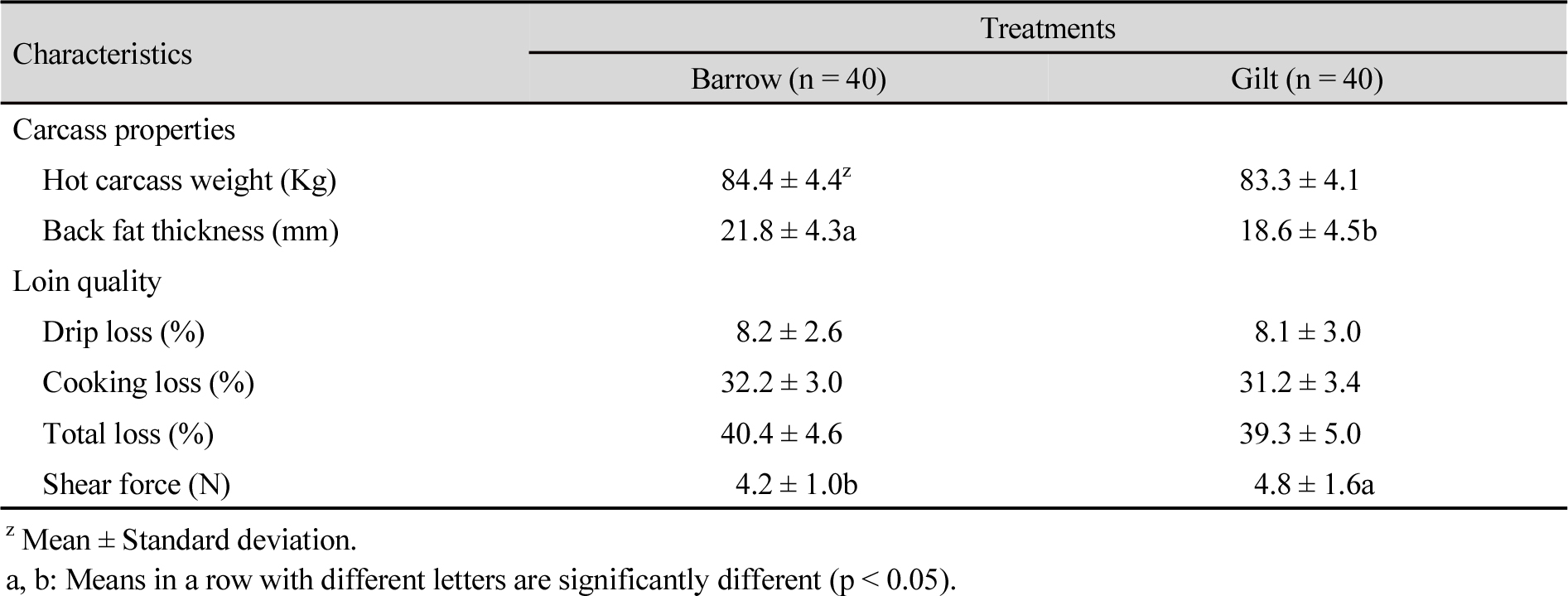
- Correlation of electrical conductivity and color with water loss and shear force of pork loin
- Hayeon Jeon, Seul-Ki-Chan Jeong, Seonmin Lee, Dongjun Kim, Hyeun Bum Kim, In-Seon Bae, Yunseok Kim, Pil Nam Seong, Samooel Jung, Kyung Jo
- This study investigated the relationship of electrical conductivity and color to water loss and shear force of pork loin. In addition, the …
- This study investigated the relationship of electrical conductivity and color to water loss and shear force of pork loin. In addition, the differences in quality properties with the sex and carcass grades were investigated. There were no differences in drip loss, cooking loss, and total loss of pork loin between barrow and gilt (p > 0.05). The shear force of pork loin was lower in barrow than in gilt (p < 0.05). The quality properties of pork loin did not differ among the carcass grades (1+, 1, and 2). The electrical conductivity measured at 45 min, 3 h, and 12 h had no noticeable correlation coefficients with the quality properties of pork loin. The L*, a*, and b* values correlated significantly with cooking loss and total loss. The highest correlation coefficient was 0.45 between L* and total loss. From the results, we conclude that the electrical conductivity and color values are not suitable variables for predicting pork loin quality. Therefore, further study to develop ways for predicting the pork quality during the grading of pork carcasses is required. - COLLAPSE
-
Engineering

- Development of simulation model of an electric all-wheel-drive vehicle for agricultural work
- Min Jong Park, Hyeon Ho Jeon, Seung Yun Baek, Seung Min Baek, Dong Il Kang, Seung Jin Ma, Yong Joo Kim
- This study was conducted for simulation model development of an electric all-wheel-drive vehicle to adapt the agricultural machinery. Data measurement system was …
- This study was conducted for simulation model development of an electric all-wheel-drive vehicle to adapt the agricultural machinery. Data measurement system was installed on a four-wheel electric driven vehicle using proximity sensor, torque-meter, global positioning system (GPS) and data acquisition (DAQ) device. Axle torque and rotational speed were measured using a torque-meter and a proximity sensor. Driving test was performed on an upland field at a speed of 7 km·h-1. Simulation model was developed using a multi-body dynamics software, and tire properties were measured and calculated to reflect the similar road conditions. Measured and simulated data were compared to validate the developed simulation model performance, and axle rotational speed was selected as simulation input data and axle torque and power were selected as simulation output data. As a result of driving performance, an average axle rotational speed was 115 rpm for each wheel. Average axle torque and power were 4.50, 4.21, 4.04, and 3.22 Nm and 53.42, 50.56, 47.34, and 38.07 W on front left, front right, rear left, and rear right wheel, respectively. As a result of simulation driving, average axle torque and power were 4.51, 3.9, 4.16, and 3.32 Nm and 55.79, 48.11, 51.62, and 41.2 W on front left, front right, rear left, and rear right wheel, respectively. Absolute error of axle torque was calculated as 0.22, 7.36, 2.97, and 3.11% on front left, front right, rear left, rear right wheel, respectively, and absolute error of axle power was calculated as 4.44, 4.85, 9.04, and 8.22% on front left, front right, rear left, and rear right wheel, respectively. As a result of absolute error, it was shown that developed simulation model can be used for driving performance prediction of electric driven vehicle. Only straight driving was considered in this study, and various road and driving conditions would be considered in future study. - COLLAPSE
-
Animal
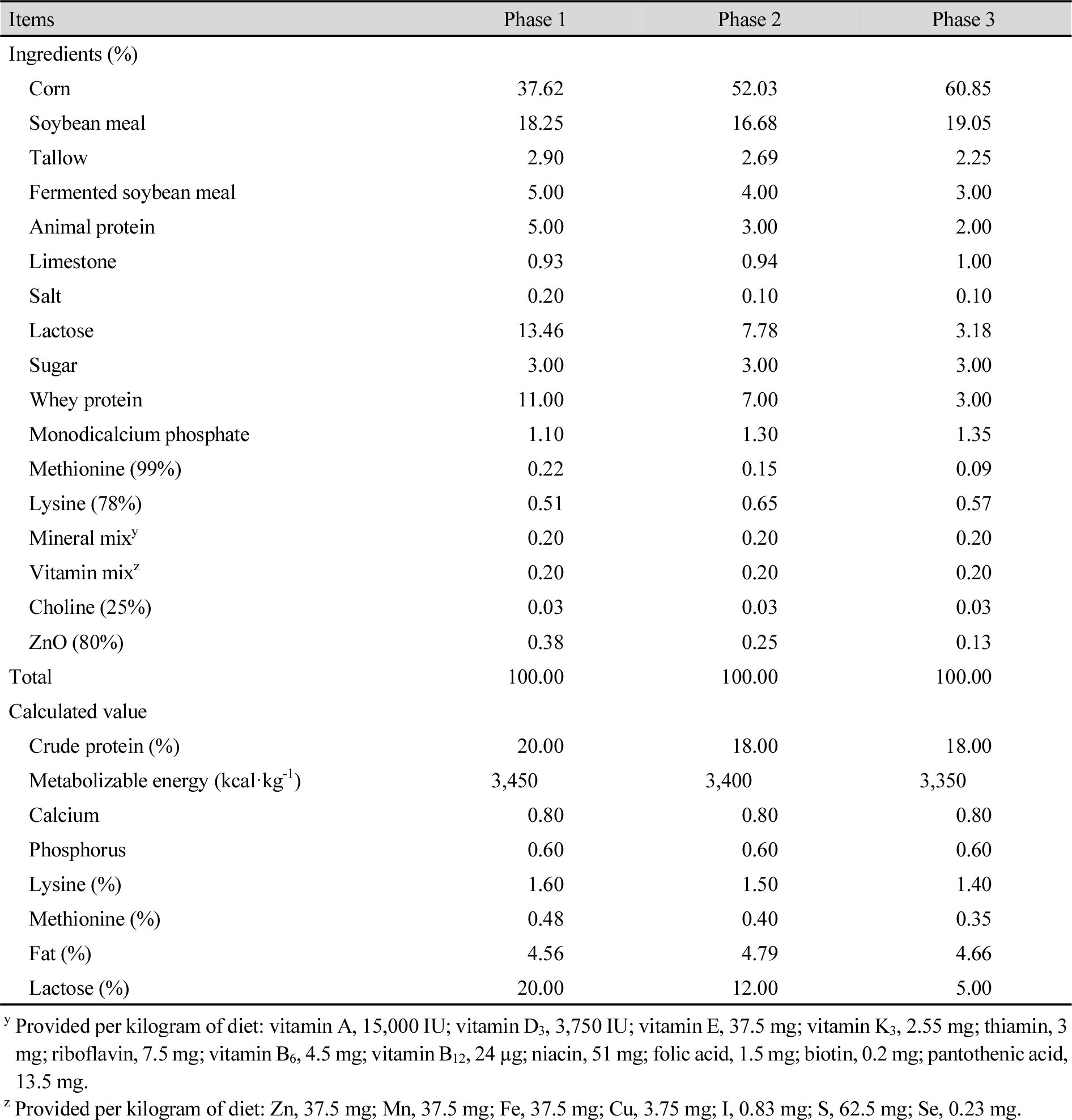
- Effect of saccharin (sweetener) supplementation on growth performance, nutrient digestibility, fecal microbial, and fecal score in weaning piglets
- Golam Sagir Ahammad, In Ho Kim
- Sweeteners are beneficial for weaning pigs as they contribute to improved palatability, increased feed intake, energy provision, gut health support, and alleviation …
- Sweeteners are beneficial for weaning pigs as they contribute to improved palatability, increased feed intake, energy provision, gut health support, and alleviation of post-weaning stress. This study was conducted to evaluate the effects of saccharin on growth performance, nutrient digestibility, fecal microbial, and fecal score of weaning pigs. A total of 80 (21 days old) crossbred ([Yorkshire × Duroc] × Landrace) healthy weaned piglets with an initial body weight (BW) of 6.85 ± 1.36 kg were randomly allotted to one of two nutritive treatments with 8 repetitions and five pigs (2 female and 3 male) per pen. The dietary treatments consisted of control (CON): basal diet; treatment (TRT): basal diet + 0.03% saccharin. The result showed that average daily gain (ADG) and average daily feed intake (ADFI) were increased (p < 0.05) in weaning fed saccharin supplemented diets compared with control diet. However, there was no significant difference in nutrient digestibility, fecal microbial, and fecal score among dietary treatments (p > 0.05). In summary, the sweetener supplementation with diet had a significant effect on ADG and ADFI without compromising nutrient digestibility, fecal microbial, and fecal score in the weaning pigs. - COLLAPSE
-
Food & Chemistry
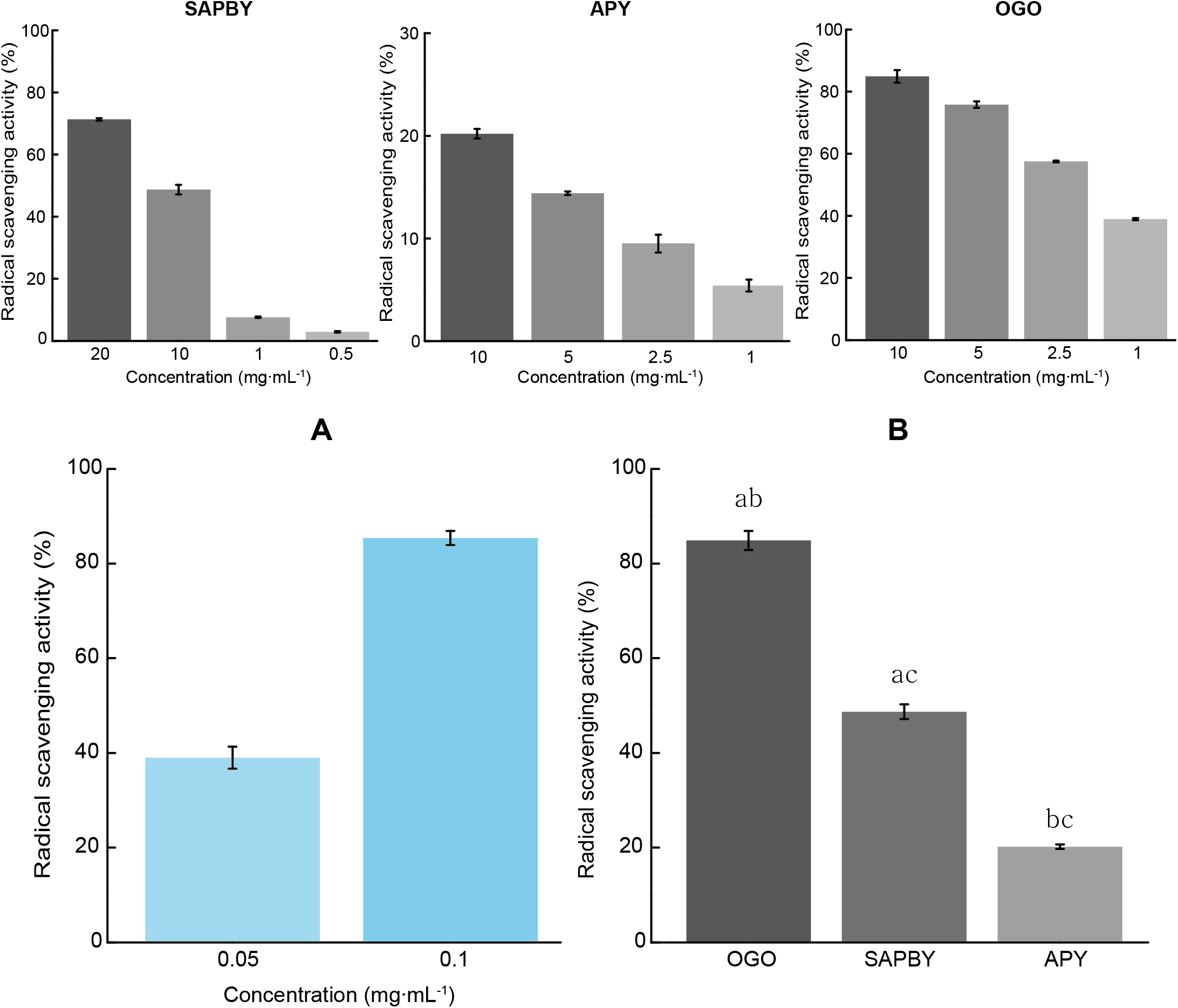
- Effects on the growth promotion of lactic acid bacteria, antimicrobial effect and antioxidant activity of natural materials
- Woo Jin Ki, Gereltuya Renchinkhand, Tae-Hwan Kim, Myoung Soo Nam
- According to various negative effects of antibiotic growth promoters, the effects of nature-derived alternatives to antibiotic growth promoters are mainly investigated in …
- According to various negative effects of antibiotic growth promoters, the effects of nature-derived alternatives to antibiotic growth promoters are mainly investigated in livestock industry these days. The effects of nature-derived alternatives to antibiotic growth promoters are mainly investigated in livestock industry these days. This study was conducted to estimate the efficiency of natural-derived alternatives to antimicrobial and antioxidant such as oregano oil (OGO), sulfide type antimicrobial peptides derived from Bacillus or Yeast (SAPBY), antimicrobial peptides derived from yeast (APY). The lactic acid bacteria growth effects were found to be minimal. The antibacterial activity of SAPBY was minimal, but OGO and APY showed antibacterial activity against Escherichia coli and Salmonella Typhimurium, and APY also showed antibacterial activity against Staphylococcus. Antioxidant effects were observed in all SAPBY, OGO, and APY, and when comparing the radical scavenging rate at 10 mg·mL-1 for each sample, OGO showed the highest at 84.9%, followed by SAPBY at 48.7%. Therefore, the substances that can be used as natural antibiotics are SAPBY, APY, and OGO. It is believed that adding these substances to feed and feeding them to livestock will greatly contribute to improving the health of livestock and the productivity of safe livestock products. In further, research focused on various nature-derived alternatives to antibiotic growth promoter in livestock industry is needed. - COLLAPSE
-
Management & Economics
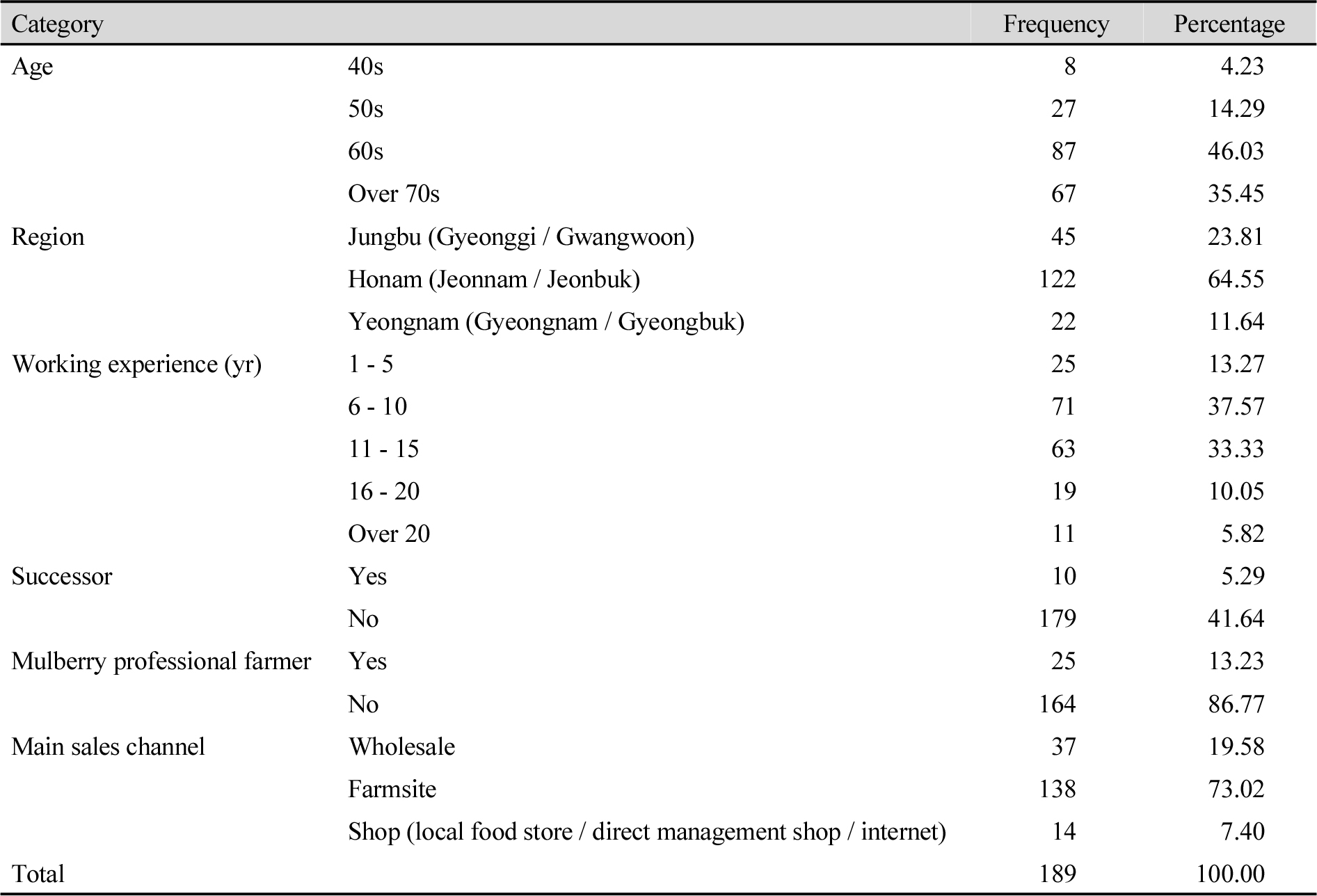
- Factors influencing mulberry fruit farmers’ choice of sales channels and farm revenue
- Seungjee Hong, Jaehong Park
- Under the global economic system, farmers are developing various sales channels in addition to traditional sales channels due to continuous changes in …
- Under the global economic system, farmers are developing various sales channels in addition to traditional sales channels due to continuous changes in the market environment and consumer behavior. As a result, many farmers have started direct marketing, and the government is implementing policies to support direct transactions to secure farm income. The purpose of this study is to identify factors affecting the selection of sales channels such as wholesale, farmsite sales, and store sales of mulberry fruit farmers using a multinomial logit model, and to present basic data for a difference in revenues by sales channel. As a result of analyzing the factors influencing the selection of sales channels of mulberry fruit farmers, it was found that the number of family members, the presence of successors, and the size of the mulberry fields have more impact than demographic characteristics such as the age and farming experience of farm owners. In addition, as a result of comparing the revenues of mulberry fruit farms by sales channel, it was found that farms with store sales as their main sales channel earned statistically significantly more revenues than farms with farm sales as their main sales channel. Based on these results, there were some suggestions for selection of sales channel for mulberry fruit farms. - COLLAPSE
-
Food & Chemistry
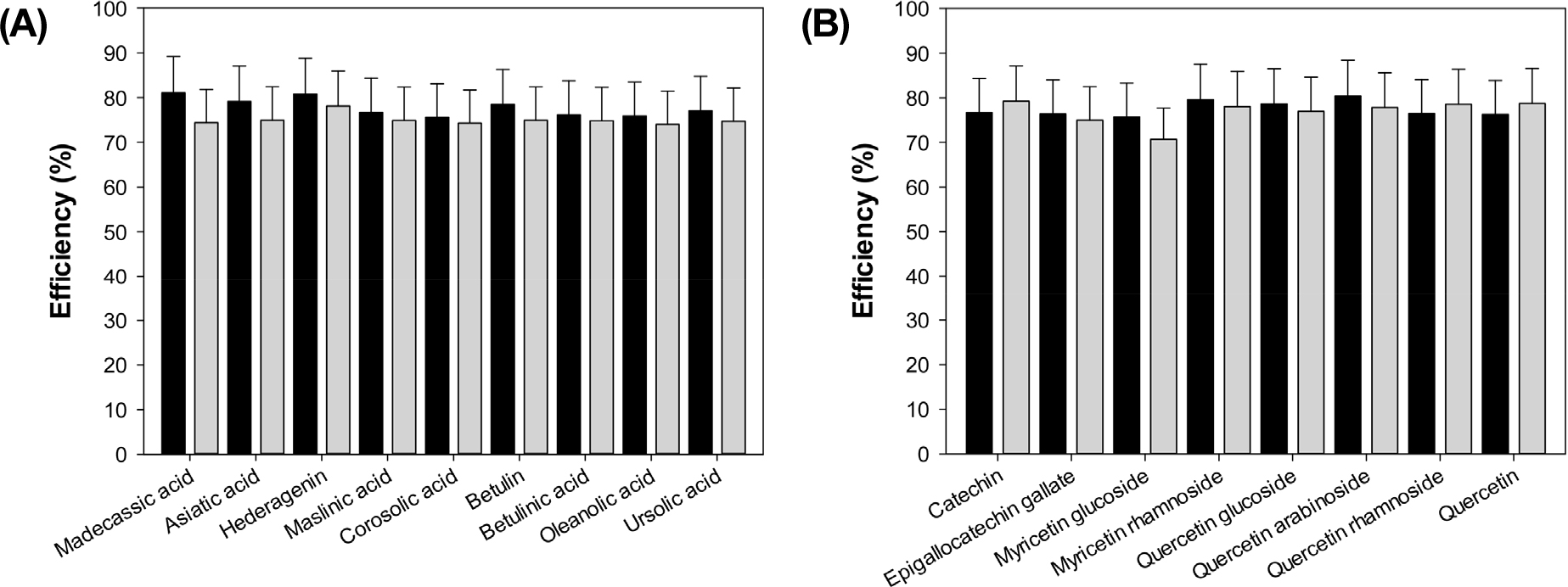
- Evaluation of processing methods and harvest timings for the efficient extraction of Syzygium formosum
- Jaeyoon Lim, Jaehan Kim, In-Seok Yeo, Jong-Tae Park
- Syzygium formosum has been traditionally used in Vietnam as a folk medicine for treating skin and respiratory diseases. With the recent recognition …
- Syzygium formosum has been traditionally used in Vietnam as a folk medicine for treating skin and respiratory diseases. With the recent recognition of its beneficial effects such as anticancer, antioxidant, and anti-inflammatory properties, there is an increasing interest in industrial extraction of its bioactive compounds, such as triterpenoids and flavonoids. In this study, the extraction efficiencies of S. formosum were analyzed by extraction methods and harvest timings. Firstly, it was found that distilled water treatment substantially eliminated almost all flavonoids, suggesting that minimal pretreatment is important to preserve both triterpenoids and flavonoids. Secondly, extractions with 70% ethanol at both lab and pilot scales effectively yielded more than 70% of triterpenoids and flavonoids from S. formosum. Lastly, to investigate the seasonal variation in phytochemicals, extracts from the leaves of S. formosum harvested in April, August, October, and December in Vietnam were analyzed. It was revealed that seasons with lower temperatures led to higher concentrations of triterpenoids and flavonoids. Specifically, December was found to be optimal for obtaining high concentrations of triterpenoid and October for flavonoid. Consequently, this research provides a foundation for the industrial application of S. formosum, providing critical insights into maximizing the extraction efficiency and phytochemical contents through optimized processing methods and strategic harvesting. - COLLAPSE
-
Engineering
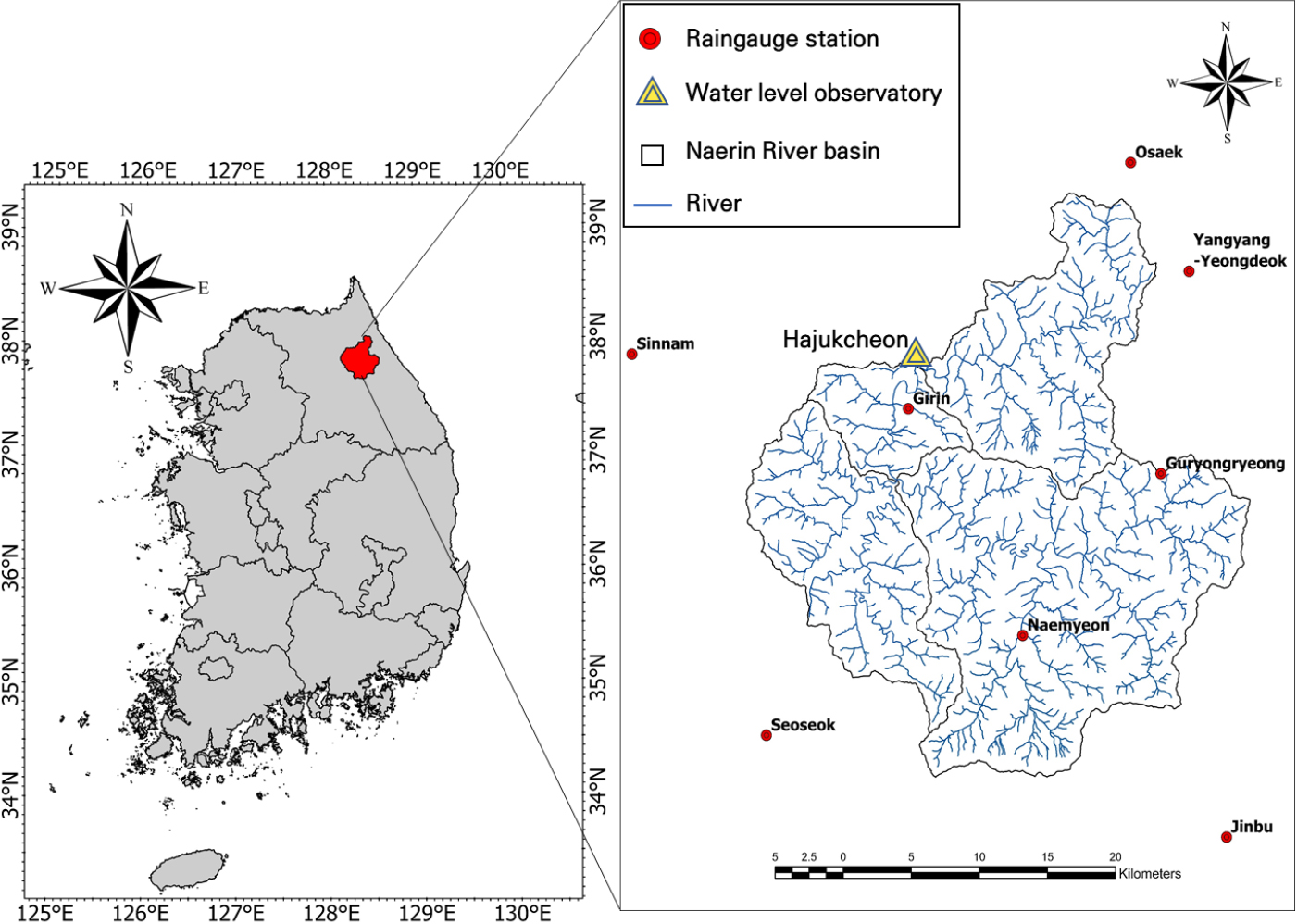
- Spatial analysis of soil erosion and deposition using physics-based distributed model
- Min Geun Song, Young Hun Kim, Chan Ul Choi, Van Linh Nguyen, Min Ho Yeon
- Soil erosion, a critical environmental issue primarily driven by water and wind, has severe consequences, including the loss of fertile agricultural land, …
- Soil erosion, a critical environmental issue primarily driven by water and wind, has severe consequences, including the loss of fertile agricultural land, degradation of water quality, and sediment accumulation in riverbeds. This study utilized the SSEM (surface soil erosion model), a physically-based distributed model, to simulate the rainfall-runoff-sediment dynamics associated with short-term rainfall events in the Naerin River basin. A spatial analysis of erosion and deposition was conducted, taking into account topographical factors such as local slope and overland flow length. The study area was segmented into six sub-catchments using Strahler’s stream order method to examine the correlation between geographic factors and erosion or deposition. The findings revealed that erosion was predominant within flow path distances of 0 - 1 km (adjacent to the river) and 3 - 4 km (in the upper catchment areas). Notably, deposition did not occur in areas beyond 2.5 km from the river. Furthermore, it was observed that average erosion depth increased on steeper slopes (exceeding 0.3 - 0.4 degrees), whereas deposition was absent in these steep slope classes. - COLLAPSE
-
Animal
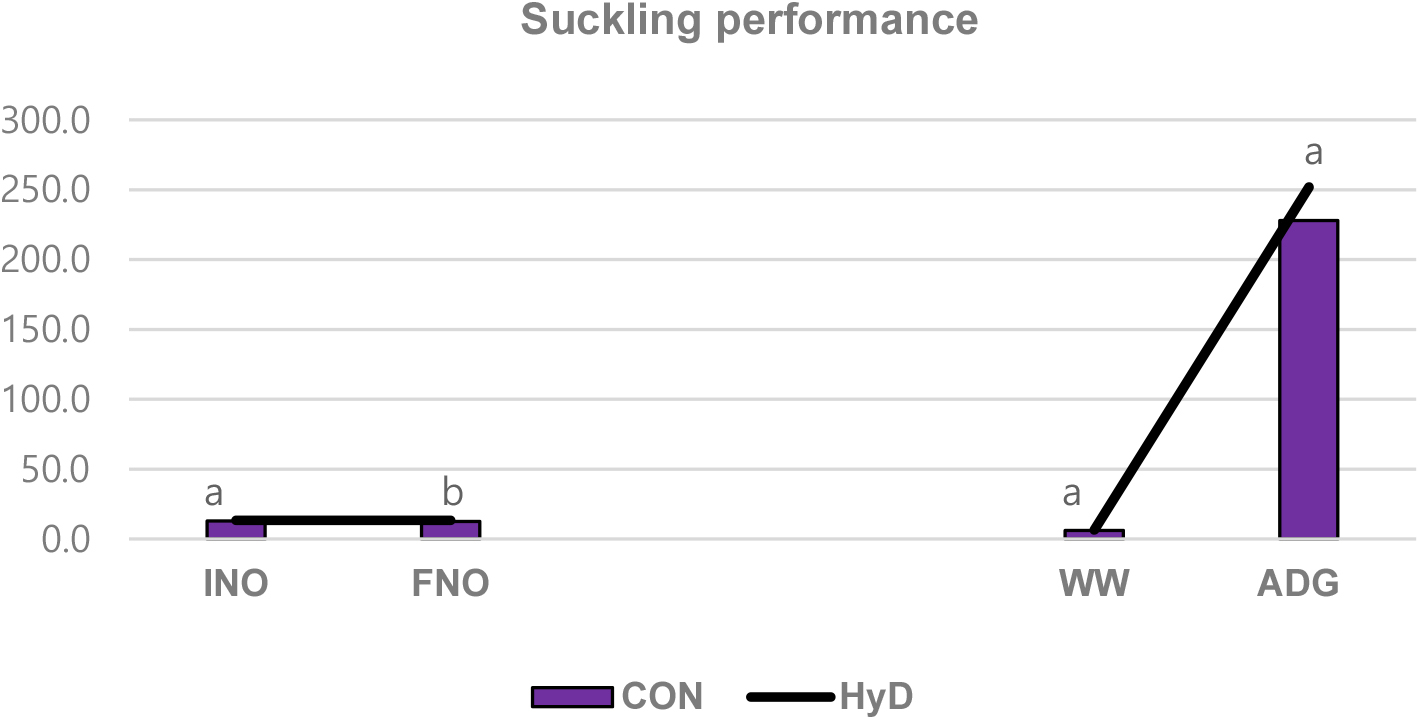
- Supplementing maternal sows’ diet with 25-hydroxyvitamin D3 increased milk profile and the health status of their young ones
- Vetriselvi Sampath, In Ho Kim
- A total of 10 sows (average body weight of 185.5 kg, Landrace × Yorkshire) and their progenies were utilized in this experiment. …
- A total of 10 sows (average body weight of 185.5 kg, Landrace × Yorkshire) and their progenies were utilized in this experiment. At first, sows were randomly allotted to 1 of 2 dietary treatments with 5 replicates of 1 sow and its litter per pen following a randomized complete block design. The test treatments were: Control (CON) basal diet and a basal diet supplemented with 0.036% of 25-hydroxyvitamin D3 (25(OH)D3). Sows fed diet supplemented with 25(OH)D3 had no adverse effect on their reproduction performance such as body weight, average daily feed intake, body weight loss, and body weight loss difference during before farrowing, after farrowing, and at weaning. Piglets born from sows fed dietary 25(OH)D3 showed significantly increased (p < 0.05) weaning weight and average daily gain. Sows fed diet supplemented with 25(OH)D3 had high total solid (TS) colostrum concentration at week 1, however at the end of week 3 the TS level had decreased approximately 2%. We believe that the positive findings of the present study could establish a major constituent for the swine mammary secretions and provide a reliable groundwork for future experiments in animal husbandry. - COLLAPSE
-
Management & Economics

- Consumer response analysis to use-by date labeling system: Focused on willingness to accept
- Jong Mun Kim, You Been Jo, Seung Hyun Han, Uhn-Soon Gim
- This study aimed to analyze consumers’ behaviors and reactions to the use-by date labeling system and provide policy implications for its efficient …
- This study aimed to analyze consumers’ behaviors and reactions to the use-by date labeling system and provide policy implications for its efficient implementation, by utilizing 213 consumers data conducted via an Internet survey using the Google online form. We refer “pure consumption date” as the period that have passed sell-by date yet have not passed use-by date. Consumers’ willingness to accept (WTA) for pure consumption date food was surveyed, which means the discount ratio of pure consumption date food compared to the original price by sell-by date. Setting the expected effects of use-by date labeling system as five: food waste reduction (waste), food purchasing cost reduction (cost), and international standardization (standard), etc., Tobit regression result showed waste had the greatest (negative) impact on consumer’s WTA, while cost and standard had positive impact on consumer’s WTA. The logistic regression result revealed that consumers trying to reduce grocery costs have higher probability to purchase use-by date labeling food, and further expect higher WTA. Also consumers valuing the importance of environmental protection or food quality are more likely to purchase use-by date food. Conversely consumers valuing food safety importance tend to have negative impact on purchasing use-by date food, hence expect higher WTA. It is note-worthy that consumers valuing the importance of promoting the use-by date labeling system have significantly higher probability of purchasing use-by date food. Additionally, consumers’ WTA averaged 54.3%, implying that consumers are willing to purchase use-by date food when it is discounted more than 54.3% from the original price, where women expect higher WTA, the aged over 60 expect higher WTA, furthermore single-parent households expect 21.3% higher than the average WTA. However, old-aged, unmarried women, higher educated and higher income groups were negative in purchasing use-by date food. These results suggest that customized sales policy and effective promotion strategies reflecting socio-demographic characteristics of consumers would be necessary to achieve effective implementation of the newly introduced system. - COLLAPSE
Journal Informaiton
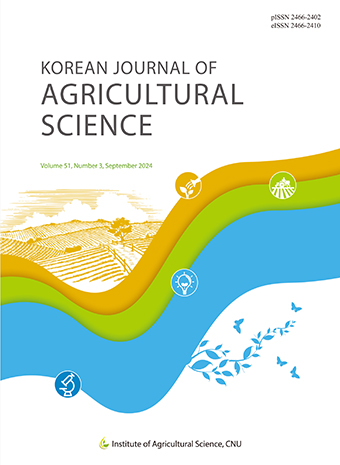 Korean Journal of Agricultural Science
Korean Journal of Agricultural Science
Journal Informaiton
Journal Informaiton - close
 Korean Journal of Agricultural Science
Korean Journal of Agricultural Science








